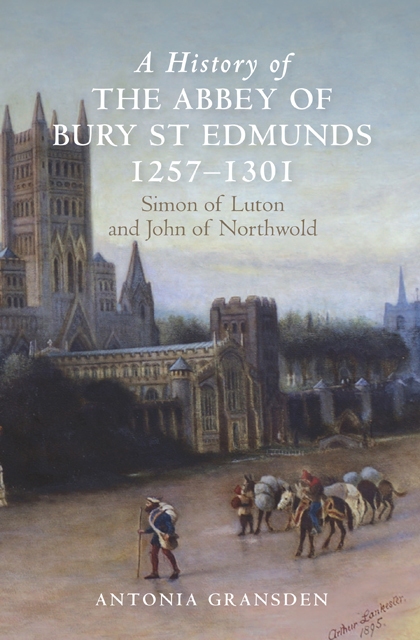Book contents
- Frontmatter
- Dedication
- Contents
- List of plates
- List of figures
- Preface
- Editorial note
- Dedication
- Acknowledgements
- Abbreviations
- Maps and plans (figures 1–11)
- Part I Introduction
- Part II Abbatial Governance
- Part III The Abbey’s Economy
- Part IV Religious Life and Reform
- Part V Intellectual and Cultural Life
- Appendix I The identity of the abbot’s justices, Henry of Guildford and Henry of Shenholt (in 1287)
- Appendix II The monks’ dietary regime: their food and drink
- Select List of the Registers and Customaries Cited
- Select List of Further Manuscripts Cited
- Select Bibliography
- Index
- Backmatter
1 - The Abbots, Simon of Luton and John of Northwold
Published online by Cambridge University Press: 22 February 2023
- Frontmatter
- Dedication
- Contents
- List of plates
- List of figures
- Preface
- Editorial note
- Dedication
- Acknowledgements
- Abbreviations
- Maps and plans (figures 1–11)
- Part I Introduction
- Part II Abbatial Governance
- Part III The Abbey’s Economy
- Part IV Religious Life and Reform
- Part V Intellectual and Cultural Life
- Appendix I The identity of the abbot’s justices, Henry of Guildford and Henry of Shenholt (in 1287)
- Appendix II The monks’ dietary regime: their food and drink
- Select List of the Registers and Customaries Cited
- Select List of Further Manuscripts Cited
- Select Bibliography
- Index
- Backmatter
Summary
Simon of Luton, Abbot 1257–79: family, early career and election as abbot
Simon ruled the abbey with varying degrees of success through difficult times. He apparently belonged to the prosperous gentry class. His ‘kinsmen (parentes) and friends’ paid for the magnificent Lady Chapel (the last major addition to the abbey church), which he constructed late in his abbacy. He was possibly related to Sir Robert of Hoo (or ‘Hose’ or ‘Hou’), a knight of St Edmunds. Simon of Luton’s toponymic suggests a relationship to the Hoo family since one of Sir Robert’s holdings was Hyde, near Luton in Bedfordshire, and the sacrist under Simon’s successor, John of Northwold, was called William of Hoo, or, alternatively, William of Luton. The Hoo family was a large one with many branches. Its principal holdings were in Bedfordshire, the east Midlands and East Anglia and included the fees of Mickfield (Suffolk) and Topcroft (Norfolk) which the family had held from St Edmunds probably since the Norman Conquest. Sir Robert held the manor of Clopton within St Edmunds’ Liberty and witnessed a number of the abbey’s charters in Abbot Simon’s time. He also gave Barton Parva to St Edmunds some time before 1268: it was bound to pay the king annually an unmewed hawk worth 20s, besides paying 60s to a chaplain to celebrate for Sir Robert’s soul perpetually.
Simon’s father was called Thomas and he was among those whose anniversary was commemorated by the monks. Just possibly he was the Thomas of Luton who appears in the witness lists of a few of the charters dateable to Abbot Simon’s time, for which Sir Robert of Hoo was the principal witness. Two of the grants are in free alms and to the almonry, an office which, as we shall see, Simon held before his succession to the abbacy. These grants were witnessed by both Sir Robert of Hoo and Thomas of Luton. In one, the long witness list starts with the names of Sir Robert and another knight; next comes Thomas of Luton, before William, bailiff of St Edmunds and the other witnesses. In the other charter the witness list again starts with Sir Robert, followed by three other knights and the rector of Woolpit; Thomas of Luton is next, before Osbert Bardolf and William, bailiff of St Edmunds.
- Type
- Chapter
- Information
- A History of the Abbey of Bury St Edmunds, 1257-1301Simon of Luton and John of Northwold, pp. 3 - 12Publisher: Boydell & BrewerPrint publication year: 2015

